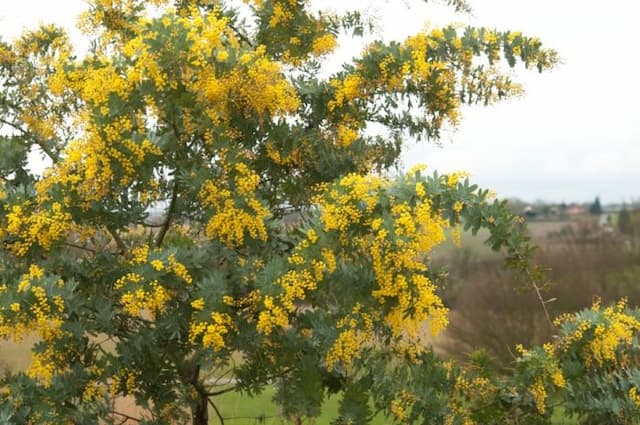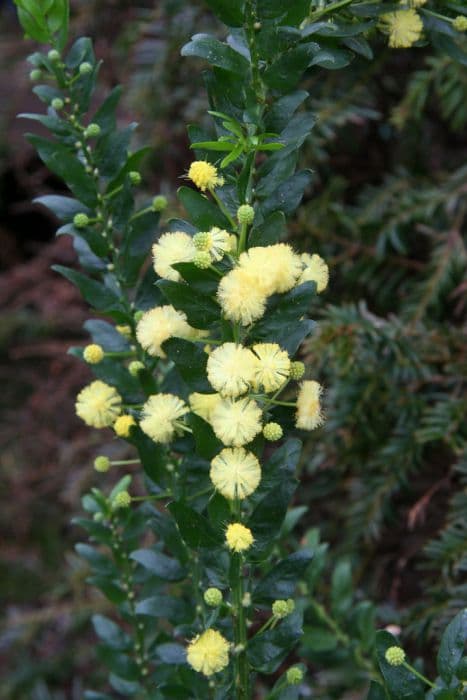Hungarian clover Trifolium pannonicum

ABOUT
The plant known as Hungarian clover is a visually striking species. It has the distinctive feature of three-part leaves, as implied by its name, with leaflets that are broadly oval and often have a darker patch in the center. These leaflets are arranged in a clover-like pattern, indicative of its membership in the clover family. The leaves are borne on stems that give the plant a bushy appearance. During its blooming period, Hungarian clover produces dense, spherical flower heads that are a vibrant shade of pink to purplish-pink, which makes them stand out in their natural settings. The flowers are small and tubular, clustered tightly together to form the rounded heads that are typical of clovers, and they attract a variety of pollinators like bees. The plant's overall structure creates a textured and lush appearance, with the combination of its clover leaves and rounded, colorful flower heads. The rich green of the foliage contrasts beautifully with the warm tones of the blooms, making Hungarian clover a distinct and attractive plant in its natural habitat.
About this plant
 Names
NamesFamily
Fabaceae
Synonyms
Hungarian Clover, Pannonian Clover
Common names
Chrysaspis pannonicum, Trifolium alpestre, Trifolium alpestre var. pannonicum, Trifolium pannonicum var. alpestre, Trifolium pannonicum var. parnassicum.
 Toxicity
ToxicityTo humans
Trifolium pannonicum, commonly known as Hungarian clover, is not widely recognized for its toxicity to humans. There is limited information on the ingestion of Hungarian clover causing adverse effects in people. However, as with any plant, individuals may have allergic reactions or sensitivities. It is always advisable to practice caution and avoid ingesting plants that are not well-known for their edibility or have not been confirmed safe by reliable sources.
To pets
Hungarian clover, or Trifolium pannonicum, is not commonly known to be toxic to pets. There is a lack of documented cases of poisoning in domestic animals from consuming this plant. However, individual pets may have allergies or intolerances to certain plants. As a precautionary measure, pet owners should monitor their animals for any signs of distress after ingesting unfamiliar vegetation and consult a veterinarian if any adverse reactions occur.
 Characteristics
CharacteristicsLife cycle
Perennials
Foliage type
Deciduous
Color of leaves
Green
Flower color
Pink
Height
1-2 feet (30-60 cm)
Spread
1-2 feet (30-60 cm)
Plant type
Herb
Hardiness zones
4-8
Native area
Europe
Benefits
 General Benefits
General Benefits- Nitrogen fixation: Trifolium pannonicum, commonly known as Hungarian clover, has the ability to fix atmospheric nitrogen, enriching soil fertility and reducing the need for synthetic fertilizers.
- Feed for livestock: It serves as high-quality forage for livestock, providing essential nutrients and promoting animal health.
- Biodiversity support: By offering habitat and food, it supports a variety of wildlife, including pollinators essential for plant reproduction and ecosystem balance.
- Erosion control: The root system of Hungarian clover helps stabilize soil and prevent erosion, particularly in sloped or degraded areas.
- Soil structure improvement: It enhances soil structure by increasing organic matter content and aiding in soil aggregation.
- Habitat restoration: Its use in habitat restoration projects helps reestablish native flora and repair damaged ecosystems.
- Weed suppression: As a cover crop, it can outcompete weeds, reducing the need for chemical herbicides.
 Medical Properties
Medical Properties- Anti-inflammatory: Trifolium pannonicum may possess anti-inflammatory properties, potentially helping to reduce inflammation in the body.
- Diuretic effect: It may have diuretic effects, which can help in increasing the production of urine.
- Expectorant: The plant might be used as an expectorant, aiding in the clearing of mucus from the airways.
 Air-purifying Qualities
Air-purifying QualitiesThis plant is not specifically known for air purifying qualities.
 Other Uses
Other Uses- Soil improvement: Hungarian clover is often used as a cover crop to enrich the soil with nitrogen, which benefits subsequent plantings.
- Forage for livestock: Hungarian clover serves as a high-quality forage for animals such as cows, sheep, and goats due to its nutritional content.
- Erosion control: The robust root system of Hungarian clover helps to stabilize soil and prevent erosion on slopes or in areas prone to soil loss.
- Support for beneficial insects: Hungarian clover is known to attract pollinators such as bees and butterflies, enhancing local biodiversity.
- Biodegradable mulch: Once harvested, the plant could be used as an organic mulch in gardens to suppress weeds and add nutrients to the soil as it decomposes.
- Pasture management: Regular planting of Hungarian clover in pastures can improve the soil quality and provide a sustainable feed source for grazing animals.
- Companion planting: Gardeners may plant Hungarian clover among vegetables as a companion plant to take advantage of its nitrogen-fixing abilities.
- Habitat restoration: It can be included in seed mixes for restoring native habitats, as it is adept at thriving in various conditions and can help establish vegetation cover.
- Green manure: Incorporated into the soil while green or shortly after flowering, Hungarian clover can act as an effective green manure to enrich the soil organically.
- Crafts and dye: The flowers and stems could potentially be used to create natural dyes or be included in craft projects for their aesthetic value.
Interesting Facts
 Feng Shui
Feng ShuiThe Hungarian clover is not used in Feng Shui practice.
 Zodiac Sign Compitability
Zodiac Sign CompitabilityThe Hungarian clover is not used in astrology practice.
 Plant Symbolism
Plant Symbolism- Luck: The Hungarian clover, like other clovers, especially those with three leaves, is often associated with good luck and fortune.
- Prosperity: In various cultures, clovers are seen as symbols of financial gain and prosperity.
- Protection: Folklore sometimes attributes clovers with the ability to ward off evil spirits and bad luck.
- Vitality: Given its hardiness and ability to thrive in different conditions, the Hungarian clover can symbolize health and vitality.
- Fertility: Clover plants are also connected with fertility and abundance due to their lush growth and proliferation.
 Water
WaterHungarian clover, or Trifolium pannonicum, prefers moderate watering, maintaining moist but not waterlogged soil. It should be watered thoroughly, allowing the water to penetrate deeply into the soil, encouraging deeper root growth. Water the plant once a week with about 1-2 gallons per square yard, depending on the weather and soil type. During hotter and drier periods, increase the frequency of watering, and during cooler, wetter periods, reduce the amount. It's crucial to avoid overwatering to prevent root rot.
 Light
LightHungarian clover thrives in full sun to partial shade. The ideal location would provide at least 6 hours of direct sunlight daily while offering some protection during the hottest part of the day. An area that receives morning light and afternoon shade would be optimal, ensuring the plant gets sufficient light without being exposed to excessive heat.
 Temperature
TemperatureHungarian clover performs well in temperate conditions and tolerates a range of temperatures. It can survive minimum temperatures down to around 10°F but the ideal temperature for growth is between 60°F and 75°F. Avoid exposing the plant to extremes of cold or heat, as temperatures above 85°F might stress the plant.
 Pruning
PruningPruning Hungarian clover is essential to promote vigorous growth and to maintain a tidy appearance. Trim back the plant in early spring to remove any dead or damaged tissue and to encourage fresh, new growth. Hungarian clover can also be cut back after the first bloom to promote a second flowering period. Prune annually or as needed to keep the plant healthy and well-shaped.
 Cleaning
CleaningAs needed
 Soil
SoilPannonian Clover prefers a well-draining soil mix with a pH range from 6.0 to 7.5, leaning towards neutral to slightly alkaline conditions. A mix of loamy soil with some sand and organic matter will mimic its natural habitat and provide the best growth results. Ensure the soil is fertile and has good moisture retention without becoming waterlogged.
 Repotting
RepottingPannonian Clover typically doesn't need frequent repotting as it is often grown as an annual or biennial. If it is grown as a perennial, repotting every couple of years should suffice to refresh the soil and provide the plant with nutrients. Always use a fresh soil mix that matches the preferred pH and structure when repotting.
 Humidity & Misting
Humidity & MistingPannonian Clover thrives in moderate humidity conditions. It does not have specific high humidity requirements and can tolerate the humidity levels typically found in temperate climates. Ensuring good air circulation around the plant will help maintain healthy growth.
 Suitable locations
Suitable locationsIndoor
Ensure good light, mild temperatures, and a pot with drainage.
Outdoor
Choose sunny spot, well-draining soil, and water regularly.
Hardiness zone
4-8 USDA
 Life cycle
Life cycleTrifolium pannonicum, commonly known as Hungarian Clover, typically starts its life cycle when its seeds germinate in the soil, given appropriate moisture and temperature conditions. The seedlings emerge and establish a root system while developing their first true leaves. As the plant matures, it forms a rosette of trifoliate leaves and begins vegetative growth, eventually producing a flowering stalk. The flowers of Hungarian Clover, usually pink or white, are pollinated by insects, after which they set seed in the form of pods. Upon maturity, these seeds are dispersed by various means such as animals, wind, or manual collection, ready to initiate the next generation. The plant may exhibit a perennial habit, surviving through multiple seasons, or behave as an annual or biennial depending on the climate and growing conditions.
 Propogation
PropogationPropogation time
Spring to early summer
Propogation: Hungarian clover, or Trifolium pannonicum, is commonly propagated through seeds, which is its most popular method of propagation. The ideal time for sowing the seeds is in early spring or fall. To facilitate germination, seeds should be scarified, which is a process of breaking or softening the seed coat to allow water absorption. After scarification, the seeds are sown at a shallow depth, typically not more than 1/4 inch (6 millimeters) deep, in well-draining soil and spaced sufficiently to allow for adequate air circulation and growth. Germination can take anywhere from several days to a couple of weeks, after which the seedlings need to be gradually acclimated to outdoor conditions if started indoors. Once established, Hungarian clover can reseed itself and thus perpetuate its presence in the planting area.









